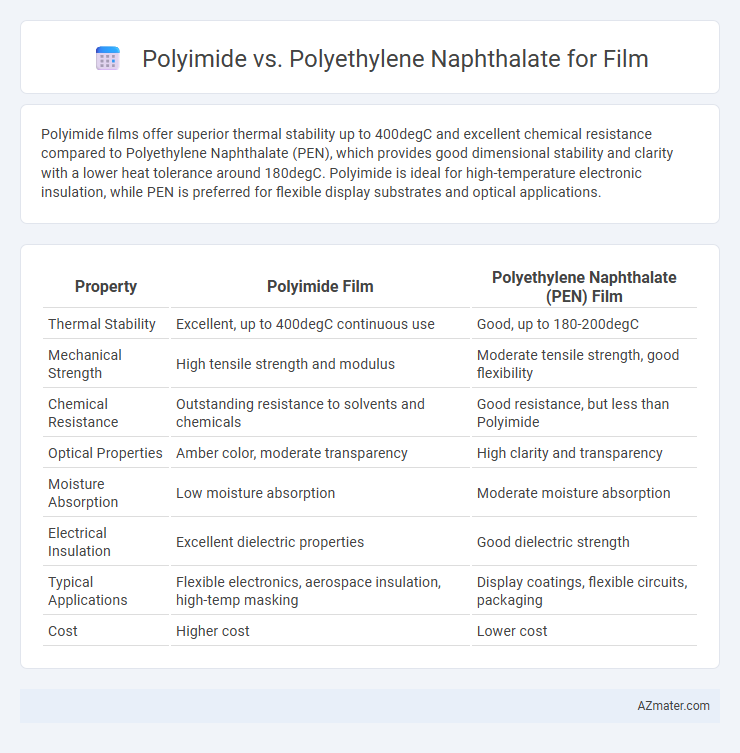Polyimide films offer superior thermal stability up to 400degC and excellent chemical resistance compared to Polyethylene Naphthalate (PEN), which provides good dimensional stability and clarity with a lower heat tolerance around 180degC. Polyimide is ideal for high-temperature electronic insulation, while PEN is preferred for flexible display substrates and optical applications.
Table of Comparison
| Property | Polyimide Film | Polyethylene Naphthalate (PEN) Film |
|---|---|---|
| Thermal Stability | Excellent, up to 400degC continuous use | Good, up to 180-200degC |
| Mechanical Strength | High tensile strength and modulus | Moderate tensile strength, good flexibility |
| Chemical Resistance | Outstanding resistance to solvents and chemicals | Good resistance, but less than Polyimide |
| Optical Properties | Amber color, moderate transparency | High clarity and transparency |
| Moisture Absorption | Low moisture absorption | Moderate moisture absorption |
| Electrical Insulation | Excellent dielectric properties | Good dielectric strength |
| Typical Applications | Flexible electronics, aerospace insulation, high-temp masking | Display coatings, flexible circuits, packaging |
| Cost | Higher cost | Lower cost |
Introduction to Polyimide and Polyethylene Naphthalate Films
Polyimide films exhibit exceptional thermal stability, chemical resistance, and mechanical strength, making them ideal for high-temperature and demanding applications in electronics and aerospace. Polyethylene Naphthalate (PEN) films offer superior dimensional stability, high tensile strength, and excellent barrier properties, suitable for flexible electronics, packaging, and optical uses. Both films provide unique advantages in flexibility and durability, with Polyimide excelling in extreme environments and PEN favoring applications requiring transparency and resistance to moisture.
Chemical Structure Comparison
Polyimide films feature aromatic imide groups providing exceptional thermal stability and chemical resistance, while polyethylene naphthalate (PEN) films are characterized by a naphthalate ester linkage, offering enhanced barrier properties and dimensional stability. The rigid aromatic rings in polyimide's imide structure contribute to superior mechanical strength and high-temperature performance compared to the more flexible ester bonds in PEN. PEN's chemical structure imparts increased resistance to hydrolysis and UV degradation, making it favorable for applications requiring transparency and durability.
Thermal Stability and Heat Resistance
Polyimide films exhibit superior thermal stability withstanding continuous use temperatures up to 400degC, making them highly suitable for high-temperature applications, whereas Polyethylene Naphthalate (PEN) films typically endure temperatures up to 180degC before degradation. The exceptional heat resistance of Polyimide is attributed to its aromatic imide groups, offering enhanced structural integrity under extended thermal exposure compared to the semi-aromatic polyester backbone of PEN. When selecting films for electronics, aerospace, or flexible circuits, the higher glass transition temperature (Tg) of Polyimide around 360degC significantly outperforms PEN's Tg near 120degC, ensuring reliable performance in demanding thermal environments.
Mechanical Strength and Durability
Polyimide films exhibit superior mechanical strength and high-temperature durability, maintaining structural integrity at temperatures up to 400degC, making them ideal for aerospace and electronics applications. Polyethylene naphthalate (PEN) offers good mechanical strength with enhanced flexibility and excellent chemical resistance but has a lower thermal stability range, typically around 190-220degC. The choice between polyimide and PEN depends on the balance of temperature resistance and mechanical flexibility required for specific film applications.
Electrical Insulation Properties
Polyimide films exhibit superior electrical insulation properties compared to polyethylene naphthalate (PEN), with high dielectric strength typically above 300 kV/mm and excellent thermal stability up to 400degC, making them ideal for demanding electrical applications. PEN offers moderate dielectric strength around 100-150 kV/mm and good dimensional stability but has lower thermal resistance, limiting its use in high-temperature electrical insulation. The molecular structure of polyimide, featuring aromatic imide groups, provides enhanced resistance to electrical breakdown and faster recovery from voltage stress than the ester linkages in PEN films.
Moisture and Chemical Resistance
Polyimide films exhibit superior moisture resistance due to their low water absorption rate, making them ideal for high-humidity environments. Polyethylene naphthalate (PEN) offers excellent chemical resistance against solvents and acids, although its moisture barrier properties are generally lower than those of polyimide. Both materials provide robust chemical stability, but polyimide's performance is preferred in applications requiring enhanced moisture protection.
Optical Clarity and Light Transmission
Polyimide films typically exhibit lower optical clarity and light transmission compared to Polyethylene Naphthalate (PEN) films, which are known for their excellent transparency and high light transmittance exceeding 85%. PEN films offer superior optical properties, including minimal yellowing and high dimensional stability under UV exposure, making them ideal for advanced optical and display applications. Polyimide films, while mechanically robust and heat resistant, often have a brownish tint that reduces their suitability where maximum clarity and light passage are critical.
Common Industrial Applications
Polyimide films are widely used in flexible electronics, aerospace insulation, and high-temperature masking due to their excellent thermal stability and mechanical strength. Polyethylene naphthalate (PEN) films excel in optical displays, solar cells, and high-performance packaging applications, offering superior dimensional stability and chemical resistance compared to traditional polyester films. Both materials serve critical roles in the electronics and packaging industries, with polyimide favored for extreme environments and PEN preferred for clarity and barrier properties.
Cost Analysis and Availability
Polyethylene naphthalate (PEN) films generally offer a more cost-effective solution compared to polyimide films, especially for large-volume applications due to lower raw material and processing costs. Polyimide films provide superior thermal stability and chemical resistance but come at a higher price point and often face limited availability from suppliers. Availability of PEN is broader in commercial markets, making it a preferred choice for cost-sensitive projects requiring good electrical and mechanical properties.
Environmental Impact and Recycling
Polyimide films exhibit exceptional thermal stability and chemical resistance, leading to longer product lifespans and reduced waste generation compared to polyethylene naphthalate (PEN). PEN films offer better recyclability due to their simpler chemical structure and compatibility with existing recycling streams, resulting in higher recovery rates and lower environmental impact during end-of-life processing. Life cycle assessments highlight that PEN's more straightforward recycling processes contribute to a smaller carbon footprint than polyimide, despite polyimide's durability advantages.

Infographic: Polyimide vs Polyethylene Naphthalate for Film
 azmater.com
azmater.com